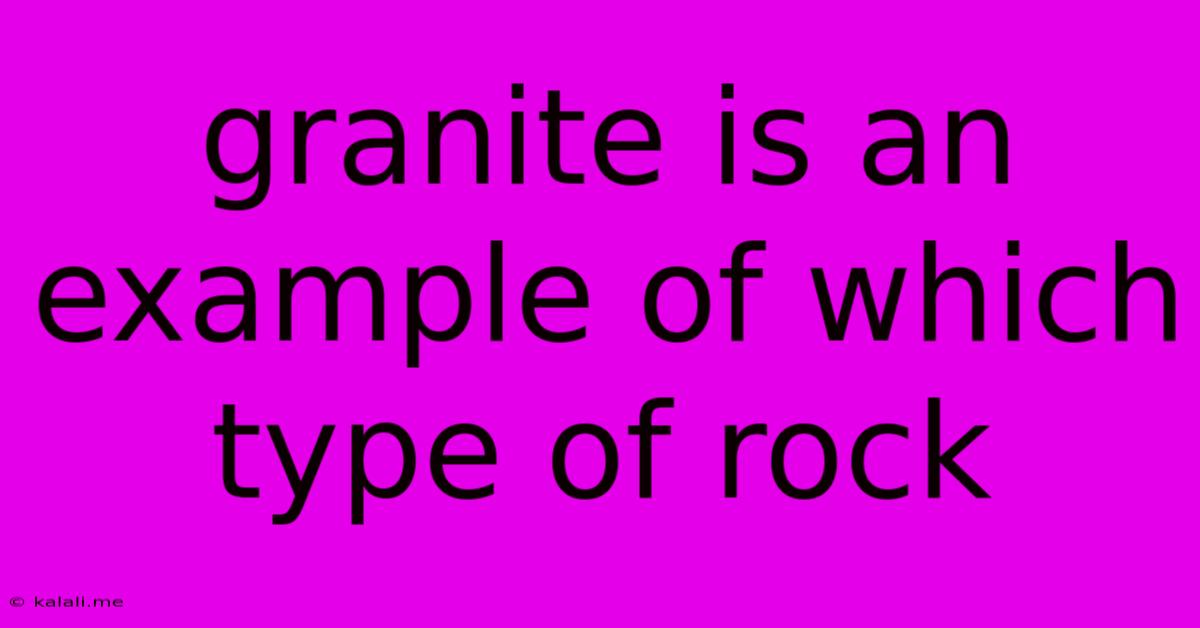Granite Is An Example Of Which Type Of Rock
Kalali
Jun 15, 2025 · 3 min read

Table of Contents
Granite: A Deep Dive into This Igneous Rock
Granite, a rock synonymous with strength and beauty, often adorns countertops, monuments, and even building facades. But what exactly is granite, and what type of rock does it represent? This article will explore the fascinating world of granite, its formation, characteristics, and its classification within the broader context of rock types.
Granite is an example of an igneous rock. More specifically, it's an intrusive igneous rock, meaning it solidified slowly beneath the Earth's surface from molten magma. This slow cooling process allows for the formation of large, visible mineral crystals, a characteristic feature of granite. Understanding this fundamental classification is crucial to appreciating granite's unique properties.
The Formation of Granite: A Journey from Magma to Mountain
The journey of granite begins deep within the Earth's crust, where immense pressure and heat melt rock, forming magma. This magma, rich in silica, feldspar, and mica, slowly rises through fissures and cracks in the surrounding rock. The magma cools and solidifies over vast periods, often millions of years, allowing the constituent minerals ample time to crystallize into their characteristic shapes and sizes. This slow cooling process distinguishes intrusive igneous rocks, like granite, from their extrusive counterparts, which cool much more rapidly at the Earth's surface, resulting in finer-grained textures.
Key Characteristics of Granite
Several defining characteristics help identify granite:
- Composition: Primarily composed of quartz, feldspar (both orthoclase and plagioclase), and mica (biotite and muscovite). The specific proportions of these minerals can vary, leading to diverse color variations in granite.
- Texture: Phaneritic, meaning the mineral grains are large enough to be visible to the naked eye. This is a direct result of the slow cooling process.
- Color: Granite displays a wide range of colors, from light gray and pink to dark gray and even black, depending on the relative abundance of its constituent minerals. Pink granite, for example, often indicates a higher concentration of potassium feldspar.
- Hardness and Durability: Known for its exceptional hardness and durability, making it a highly sought-after material for construction and decorative purposes. This strength stems from its interlocking crystalline structure.
Granite vs. Other Igneous Rocks
While granite is an igneous rock, it's important to distinguish it from other igneous rocks. Extrusive igneous rocks, like basalt and obsidian, cool quickly at the surface and have fine-grained or glassy textures. Conversely, intrusive igneous rocks, like granite, diorite, and gabbro, cool slowly underground and exhibit coarse-grained textures. The specific mineral composition further differentiates these rock types.
Conclusion: Granite's Geological Significance
Granite's significance extends beyond its aesthetic appeal and practical applications. It provides valuable insights into Earth's geological processes, offering clues about magma formation, plate tectonics, and the evolution of continents. The study of granite contributes significantly to our understanding of the Earth's dynamic interior and its geological history. From its formation deep within the Earth's crust to its prominent role in our built environment, granite stands as a testament to the power and beauty of geological processes. Understanding that it is an intrusive igneous rock is fundamental to appreciating its unique properties and geological context.
Latest Posts
Latest Posts
-
Sat Requirements For Colorado State University
Jun 15, 2025
-
How Many Districts In Andhra Pradesh State
Jun 15, 2025
-
Can You Change Your Sat Date
Jun 15, 2025
-
The Si Unit Of Measure For Force Is
Jun 15, 2025
-
The Innermost Layer Of The Root Cortex Is The
Jun 15, 2025
Related Post
Thank you for visiting our website which covers about Granite Is An Example Of Which Type Of Rock . We hope the information provided has been useful to you. Feel free to contact us if you have any questions or need further assistance. See you next time and don't miss to bookmark.